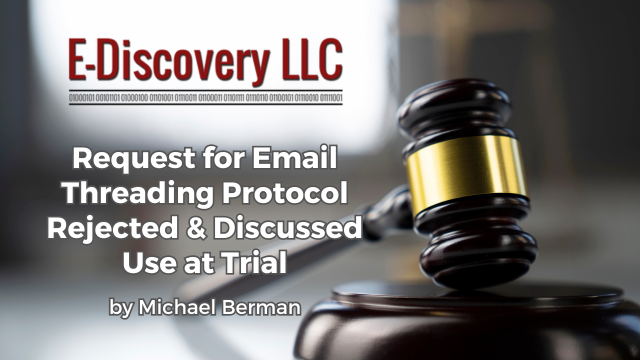
[EDRM Editor’s Note: The opinions and positions are those of Michael Berman.]
In In Re Tecfidera Antitrust Litigation, 2025 WL 2734539 (N.D. Ill. Sep. 25, 2025), the court wrote: “The parties’ cross motions for entry of their version of the ESI protocol noted that the parties agreed on all issues except for one relating to email threading, which Defendant seeks to include but Plaintiffs oppose.” Id. at *1 (emphasis added). Plaintiffs prevailed.
WHAT IS EMAIL THREADING?
The court began with a description of email threading:
“Email threading is the technical process of recombining emails that comprise an email discussion, including replies and forwards.” The Sedona Conference, Commentary on Privilege Logs, 25 Sedona Conf. J. 221, 266 (2024). Threading, or grouping all emails together, may aid reviewers in identifying gaps in production or inconsistencies more efficiently. See, e.g., Pamela Garman & Casey Terrell, Technology and Ethics: Tips for the Tech-Averse in Effectively Managing ESI in Federal Court, 24 TYL 10, 11 (Spring 2020). The process identifies inclusive emails, meaning those “containing content that is not present in its entirety in any other email in the set of emails being analyzed.” The Sedona Conference, Commentary on Privilege Logs, supra at 266 n.72. Inclusive emails are typically “the last-in-time email in any branch of the thread, as well as any email with an attachment that is not also attached to a later-in-time email that contains the full content of the earlier email.” The Sedona Conference, The Sedona Conference Glossary: eDiscovery and Digital Information Management, 5th Ed., 21 Sedona Conf. J. 263, 381 (2020).
Id. at *2.
It added:
The remaining emails are categorized as non-inclusive because their content is included elsewhere in an inclusive thread. Id. at 343. Non-inclusive emails are often suppressed to increase the speed and efficiency of review and production of large numbers of emails. See Steven M. Medlock et al., Email Threading: Streamlining Discovery Review, 41 Comput. & Internet Lawyer 1, 1 (July-Aug. 2024). When non-inclusive emails are suppressed, the content is available in the inclusive email, but the metadata attached to each suppressed email is not included in production. See Joe Leonard, Threading the Labyrinth of Modern Email Collections, 46 DSBA Bar J. 12, 13 (March 2023).
Id. at *3 (emphasis added).
What may be lost in that process? The court wrote:
The Sedona Conference notes that the discovery duties of production for metadata “are generally the same” as for other ESI, meaning that “[m]etadata … must be produced when requested and not objected to.” The Sedona Conference, Commentary on Ethics & Metadata, 14 Sedona Conf. J. 169, 184 (2013) (citation omitted). Email metadata encompasses over 1,200 properties, including when the email was sent, or when a recipient received, viewed, replied, or forwarded the message. The Sedona Principles, 3d Ed., 19 Sedona Conf. J. 1, 210 (2018). Parties are encouraged to agree early in the discovery process on whether email threading should be allowed for review or production. Id. at 71-72 (Principle 3).
Id. at *3 (emphasis added).
NO BINDING AUTHORITY
Having laid the factual groundwork, the Tecfidera Antitrust court wrote that “although both parties argue that case law supports their positions, from this court’s perspective there is no binding precedent in the Seventh Circuit regarding this issue.” Id. at *3. The court reviewed the non-binding decisions in detail. Id. at *3-4.
[A]lthough both parties argue that case law supports their positions, from this court’s perspective there is no binding precedent in the Seventh Circuit regarding this issue.
In Re Tecfidera Antitrust Litigation, 2025 WL 2734539 (N.D. Ill. Sep. 25, 2025).
It was, however, agreed by all that “producing threaded emails may be permitted (or prohibited) in a joint, stipulated ESI protocol.” Id. at *3; see Fed.R.Civ.P. 29.
USABILITY
First, the court looked at “usability” writing: “The primary benefit to email threading is that it reduces the volume of emails the producing party must review as the process involves the de-duplication of non-unique email correspondence.” Id. at *5.
However, Plaintiffs argued that the loss of metadata impeded usability. In response, Defendant offered to write a script to generate a new field populated by that metadata. Plaintiffs argued methodology that would impede data visualization. The court ruled as follows:
Despite Defendant’s assurances, the court sides with Plaintiffs. First, Plaintiffs have requested production of the emails “as they are ordinarily maintained,” which is the clearest default form of production set forth in Rule 34. Fed. R. Civ. P. 34(b)(2)(E)(ii). But Defendant proposes producing ESI in a form that deviates from the Rule 34 norm, from Plaintiffs’ request, and without demonstrating that its proposed alternative is “reasonably usable” as required. See id. This is insufficient to justify setting aside Plaintiffs’ proposal, which indisputably complies with the Rule.
Id. at *5.
In response to Defendant’s proposal to create a new metadata field, the Tecfidera Antitrust court wrote: “The fact that the metadata Plaintiffs seek can be provided in an additional field does not make it equivalent in terms of searchability and usability.” Id. It wrote that “Rule 34(b) does not state that a party can refuse to produce ESI as ordinarily maintained merely because the producing party’s alternative form is also used in discovery, see Fed. R. Civ. P. 34(b)(2)(E)(ii).” Id. at *5.
The Tecfidera Antitrust court wrote that: “During the May 2025 motion hearing, Defendant argued that Plaintiffs have not provided details to substantiate their claim that email threading would obstruct searchability, but this assertion incorrectly places the burden on Plaintiffs…. Rule 34(b) does not require that a party seeking relevant discovery justify its request that ESI be produced in the form in which it is ordinarily maintained.” Id. at *6.
Rule 34(b) does not require that a party seeking relevant discovery justify its request that ESI be produced in the form in which it is ordinarily maintained.
In Re Tecfidera Antitrust Litigation, 2025 WL 2734539 at *6 (N.D. Ill. Sep. 25, 2025).
PROPORTIONALITY
Second, the court analyzed proportionality. Defendant argued, supported by an expert affidavit, that threading strikes a balance between reducing its costs, while providing “all substantive information…..” Id. at *6.
Plaintiffs responded that the defense “has not substantiated its claims of substantial burden with any details regarding the amount of time required for review or any specifics regarding potential additional hosting costs.” Id. at *6. The court wrote:
The court agrees with Plaintiffs on this point. Defendant provides no analysis of the proportionality factors in Rule 26(b)(1) beyond unspecified claims of substantial burden that the potential scope of discovery will exacerbate…. [The Defendant’s expert’s] testimony that threading “can materially reduce the number of documents for review … result[ing] in lower document hosting costs and quicker completion” lacks sufficient specificity to assess Defendant’s alleged burden…. Likewise, that the lack of threading “can result in higher hosting costs” is devoid of both specificity and certainty…. Nonspecific or speculative claims are insufficient for the court to weigh Defendant’s burden against the remaining proportionality factors in Rule 26(b)(1).
Id. at *6.
In my words, the Plaintiffs said that the defense lacked sufficient metrics and the court agreed.
THE DOOR WAS LEFT OPEN
However, the court left the door open for “more evidence of a specific substantial burden….” Id. at *7. It added:
And a more detailed argument regarding “the importance of the [metadata] in resolving the issues” given the existence of other tools to increase searchability might change the calculus of a proportionality analysis. Fed. R. Civ. P. 26(b)(1). But as it stands now, Defendant fails to meet its burden to show that its objection on grounds of proportionality.
Id. at *7.
It denied Defendants’ threading motion without prejudice.
USE OF THREADED EMAILS IN DEPOSITION AND TRIAL
In Footnote 2, the Tecfidera Antitrust court addressed, but did not decide, a very interesting argument:
Plaintiffs also argue that excluding non-inclusive emails disadvantages trial strategy because they will be forced to present entire email threads to witnesses during depositions and examination at trial…. Because this court finds that Plaintiffs are entitled to all metadata available in the emails as requested and ordinarily maintained, this argument need not be addressed. That said, this court is skeptical of this argument. Defendant expressed willingness to agree to a protocol permitting the use of redacted emails for presentation to witnesses…. Plaintiffs cite no authority supporting the proposition that the rules of discovery require consideration of a preferred method of presenting exhibits to witnesses when determining the form of production, and they do not argue that the loss of metadata in non-inclusive emails would impact this task.
Id. at n. 2 (emphasis added).
I suggest that, if agreement on threading cannot be reached, Tecfidera Antitrust holds that a party seeking to employ threading over objection must provide specific metrics in support.
For what it is worth, I am more intrigued by the Footnote 2 argument. I suggest that many forms of ESI – such as email chains, text message chains, chats, “modern attachments,” Excel workbooks, PDF portfolios, and many more – present an important question: What is a “Document?”
Also, I am not convinced that showing a redacted email chain to a jury is equivalent to showing a focused and unredacted one. While not precisely the same context, it has been said that: “[R]edacting allegedly nonresponsive or irrelevant portions of discoverable documents ‘breed[s] suspicions.’” In re State Street Bank & Trust Co. Fixed Income Funds Inv. Litig., 2009 WL 1026013, at *1 (S.D.N.Y. Apr. 8, 2009), as quoted in Relevance Redactions Rejected – Rule 26(f) Resolution; accord Beverley v. New York City Health & Hosps. Corp., 2024 WL 1342806, at *10 (S.D.N.Y. Mar. 29, 2024); Castlelake, L.P. v. Lancashire Airline War Consortium/Airline Hull, 2024 WL 4007498, at *3 (Minn.Dist.Ct. Aug. 05, 2024); Conservation L. Found., Inc. v. Shell Oil Co., 2023 WL 5434760, at *6 (D. Conn. Aug. 22, 2023).
I think that the evidentiary argument in Footnote 2 has more force. For more on “what is a document?,” please see:
- What is a “Document?”: Interior Email Omitted from Email Chain – Sanctions Follow for Lack of Candor to Court;
- What is a Document? (Part II);
- What is a Document? (Part III);
- ESI Protocol Should Define “Documents” and Address Redaction Based on Irrelevancy; Sedona Conference Commentary on Discovery of Collaboration Platforms – What is a Document?;
- “Modern Attachments” or “Pointers”- What is a Document? (Part IV); Uber Technologies – Another Hyperlink Decision.
Assisted by GAI and LLM Technologies per EDRM GAI and LLM Policy.


